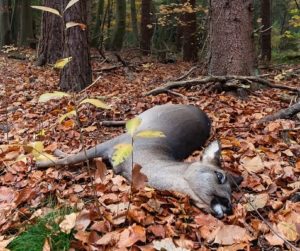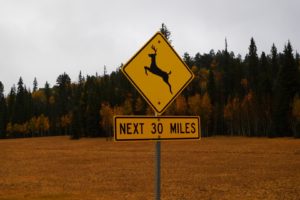How to Avoid Hitting a Deer
Attention all drivers: We all need to know how to avoid hitting deer!!!
All hunters know that during deer season (October through December) there is a dramatic increase in the movement  of the deer population. However, the average vehicle driver who does not hunt may not be aware of this season’s risk.
of the deer population. However, the average vehicle driver who does not hunt may not be aware of this season’s risk.
Many of these deer find their way onto highways and into suburban neighborhoods. As a result, more deer-vehicle collisions occur in this period than at any other time of year.
Each year, in my home state of Michigan, there are nearly 50,000 reported vehicle-deer crashes. The most serious crashes occur when motorists swerve to avoid a deer and hit another vehicle or a fixed object, or when their vehicle rolls over.
In the county where I live there were 936 deer / vehicle-related accidents reported between 2016 and 2017. Those odds more than double during October, November, and December, and there is an increased risk around dawn and dusk.
It would be so helpful if they would just cross where the sign tells them to, but they all seem to ignore that.

Below are eight things to know about how to avoid hitting a deer with your car:
- October and November are the most-common months for deer accidents
- Deer accidents are most likely to occur between 6 and 8 a.m.
- 61% of 2017 deer-vehicle crashes were on local or county roads
- Deer accidents on interstates are twice as likely to result in human injury
To avoid hitting a deer, use these defensive driving tips:
- Be especially attentive during peak deer hours. From sunset to midnight and during the hours shortly before and after sunrise are the highest risk times for deer-vehicle collisions
- Use extra caution when driving through deer-crossing zones. Also, be especially careful in places known to have a large deer population and in areas where roads divide agricultural fields from forestland.
- Know that deer seldom run alone. If you see one deer, others may be nearby.
- Use high beam headlights if driving at night, when there is no oncoming traffic. The higher light will better illuminate the eyes of deer on or near the roadway.
- Slow down and blow your horn with one long blast to frighten the deer away.
- Brake firmly but stay in your lane when you notice a deer in or near your path. Many serious crashes occur when drivers swerve to avoid a deer and hit another vehicle or lose control of their cars.
- Always wear your seat belt. Most people injured in car-deer crashes were not wearing their seat belt.
- Do not rely on deer-deterring devices. Deer whistles, deer fences, and reflectors have not been proven to reduce deer-vehicle collisions.
- If your vehicle strikes a deer, do not touch the animal. A frightened and wounded deer can hurt you or further injure itself. The best procedure is to get your car off the road, if possible, and call the police.
- In the event a deer damages your car contact your insurance company.
How many deer have you hit in your lifetime?
